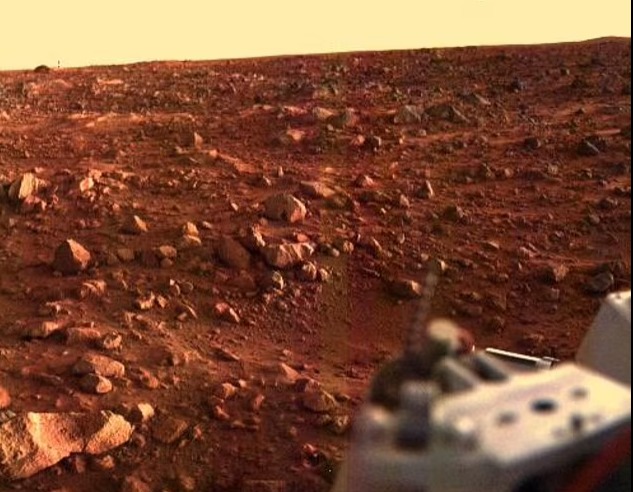The potential for extraterrestrial life on Mars has long sparked the interest of both scientists and astronomers. Now, according to recent claims by a famous researcher, NASA may have “accidentally deleted” important evidence of an alien presence on Mars half a century ago.
This article delves into this expert’s controversial claims and considers the implications for our understanding of Mars and the broader search for signs of life beyond Earth.
Jump to
- Mars cover-up? Expert claims NASA may have destroyed evidence of extraterrestrial life on the Red Planet 50 years ago
- NASA’s Viking mission landers
- Some experiments were carried out…
- Which scientists discovered life on Mars?
Mars cover-up? An expert claims that NASA may have destroyed evidence of extraterrestrial life on the red planet 50 years ago
 Credit: NASA
Credit: NASA
NASA may have discovered alien life on Mars 50 years ago when it launched its two Viking landers, but the agency mistakenly killed it.
Dirk Schulze-Makuch of the Technical University of Berlin made these claims, believing that a 1970s experiment that introduced water into the soil destroyed any life lurking in the Martian landscape.
The Viking Labeled Release experiment first gave positive results for metabolism, but further investigation found no signs of organic material. Schulze-Makuch believes that the soil water containing a nutrient solution was too liquid, “and [any life] killed after a while.
While the hypotheses may seem absurd to some, the bacteria that live inside salty rocks in the Atacama Desert, which has terrain similar to Mars, don’t need rain to exist, and too much water would kill them.
NASA’s Viking mission landers
The two landers of NASA’s Viking mission touched down on Mars on July 20, 1976 (Viking 1) and September 3, 1976 (Viking 2).
The landers were equipped with various instruments, including a gas chromatograph/mass spectrometer, an X-ray fluorescence spectrometer, a seismometer, a meteorological instrument, and color stereo cameras. The instruments allowed them to search for signs of life and examine the physical and magnetic characteristics of the soil and environment.
 Credit: NASA
Credit: NASA
In an opinion piece for BigThink, Schulze-Makuch described the findings as “puzzling,” noting that one of the tests came back positive for gas exchange, while another came back negative.
However, traces of chlorinated organic compounds were discovered. The life affirmative test added water to the soil to determine if respiration and metabolic products occurred. If life existed on Mars, bacteria would consume nutrients and emit radioactive carbon as a gas.
“If we assume that indigenous Martian life adapted to its environment by incorporating hydrogen peroxide into its cells, this could explain the Viking findings,” writes Dirk Schulze-Makuch.
«If the Martian cells had included hydrogen peroxide, they would have died. Furthermore, it would have caused the hydrogen peroxide to react with any organic molecules in the area, resulting in huge volumes of carbon dioxide, exactly what the team measured.’
Some experiments were carried out…
Another experiment, pyrolytic release, evaluated for organic synthesis, also gave positive results. This experiment combined carbon monoxide and carbon dioxide from the atmosphere to investigate whether carbon would be absorbed by the soil.
The Viking landers found chlorinated organic compounds, but experts believe they may have infected the planet with terrestrial hitchhikers.
“However, subsequent missions have confirmed the presence of native organic molecules on Mars, albeit in a chlorinated form,” said Dirk Schulze-Makuch.
 Credit: NASA
Credit: NASA
“Life on Mars could have adapted to the arid environment by surviving among salty rocks and drinking water directly from the atmosphere,” says a researcher.
“The Viking studies, in which water was added to soil samples, may have overwhelmed these potential bacteria, causing them to disappear,” says the study’s lead author.
Which scientists discovered life on Mars?
Dirk Schulze-Makuch is one of many scientists who suggest that NASA discovered life on Mars 50 years ago. The same idea was promoted in an article published in 2016.
The evidence acquired by the Viking mission is “compatible with a biological explanation,” according to experts from Arizona State University, Tempe, and the National Institutes of Health, Bethesda, implying that microorganisms on Mars adapted and evolved to resist difficult climatic circumstances.
The researchers examined the results of the 1976 Viking Labeled Release Experiment and looked at “non-biological explanations.” In the studies, Martian soil samples from both landers were injected with nutrients, preheated, and even stored in the dark for two months.
The findings were strikingly similar to those reported on terrestrial soil, including data from California, Alaska and Antarctica.
 Credit: NASA
Credit: NASA
“Each of these characteristics, including initial positive responses, 160°C and 50°C heat controls, reabsorption of evolved gas following the second nutrient injection, and death from long-term isolated storage,” the researchers wrote authors in the study.
The Viking 1 and Viking 2 landers continued their missions until their final transmissions to Earth on November 11, 1982 (Viking 1) and April 11, 1980 (Viking 2), respectively, but remain on Mars to this day. from today.
what do you think about it? Let us know in the comments.
For more trending stories, follow us on Telegram.
Categories: Trending
Source: vtt.edu.vn
